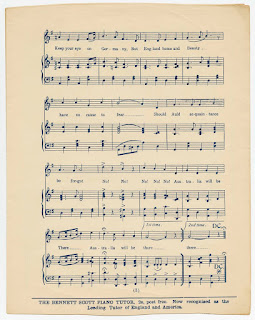"They sang 'Australia will be there' and by God, they were." Bendigo Advertiser 22 November 1915.
Of all the patriotic songs of World War I, "Australia Will Be There" was probably the best known to Australians and was immensely popular during the first World War. It became the marching song of the Australian Expeditionary Forces and was used to rally the troops as they marched away from home.
Australia Will Be There was written, composed and sung by (Walter) Skipper Francis in 1914/15, who, born in Wales, had immigrated to Australia in 1913 due to ill-health.
The song quotes from Auld Lang Syne in its chorus and is often referred to by it's longer title, "For Auld Lang Syne - Australia Will Be There". The song celebrated the nation's freedom and declared Australia's commitment to fight. It includes a reference to the defeat of the German light cruiser SMS Emden by HMAS Sydney on 9 November 1914.
Australia Will Be There - Lyrics
There are lots and lots of arguments
Going on today
As to whether dear old England
Should be brought into the fray
But all right thinking people
Know well we had to fight
For the Kaiser’s funny business
It wants some putting right.
Chorus
Rally 'round the banner of your country
Take the field with brothers o'er the foam
On land or sea
Wherever you be
Keep your eye on Germany
But England, home and beauty
Have no cause to fear
Should auld acquaintance be forgot
No, no, no, no, no!
Australia will be there
Australia will be there
You have heard about the Emden ship
Cruising all around
She was sinking British merchant men
Where'er they could be found
But one fine morning early
The Sydney hove in sight
She trained her guns upon them
And the German said ‘goodnight’
Chorus
Rally 'round the banner of your country
Take the field with brothers o'er the foam
On land or sea
Wherever you be
Keep your eye on Germany
But England, home and beauty
Have no cause to fear
Should auld acquaintance be forgot
No, no, no, no, no!
Australia will be there
Australia will be there
Sheet Music (Click to enlarge)
Video Images: Courtesy Australian War Memorial
Image 1 - H02241 - Brisbane, Queensland. c. 1918. Australian soldiers on Pinkenba wharf waiting to embark on troopship Wandilla (A62) on their way to overseas service.
Image 2 - H02008 - Fremantle, W.A., c. 1915. 10th Light Horse waiting to embark for Egypt.
Image 3 - H02377 - Port Melbourne, Victoria, c. 1917. A Melbourne crowd farewelling troops embarked on a troopship bound for overseas.
Image 4 - J06497 - Port Melbourne, Vic. 23 December 1914. Members of the 13th Battalion crowded on the wharf ready to embark on N.M.T. Ulysses, lying alongside the pier, for service overseas.
Image 5 - P07222.001 - Members of the 11th Battery, 4th Field Artillery Brigade (FAB), parade on horseback down Collins Street, Melbourne, prior to embarkation for Egypt. The 4th FAB embarked from Melbourne on HMAT Wiltshire on 18 November 1915. Identified, riding the horse with white blaze and feed bag nearest to camera, is 6552 Gunner (Gnr) Cleveland Tidcombe Hazard, of Brighton, Vic. Gnr Hazard was a farmer before enlisting on 20 September 1915. He took the horse he is riding, 'Sam', with him to Egypt and then France, before it was fatally wounded by a piece of shrapnel while advancing guns through Bapaume on 2 April 1917. On 3 February 1917 Gnr Hazard was appointed Acting Bombardier. On 15 May 1917 he was wounded in the thigh, chest and neck, and he was returned to Australia on 19 October 1917.
Image 6 - P00971.005 - Group portrait of Australian nurses. Back row, standing, left to right: Sisters Farey; Whipps McPherson; McElhone and M Lawson. Seated: Sisters Attneave; Plenderneith; Feather and Cross. The full names of these sisters are not known.
Image 7 - A00580 - Sydney, N.S.W., 1915. A crowd farewelling the troops as they leave for the Front from Central Railway Station.
Image 8 - P08414.010 - Perth, W.A., January 1915. C Troop of B Squadron, 10th Light Horse Regiment, parading on horseback through Perth prior to embarkation. Identified, leading the troop and carrying a sword, is Lieutenant Leslie Craig, Officer Commanding C Troop. A farmer prior to enlisting on 28 October 1914, he embarked at Fremantle aboard HMAT Mashobra (A47) on 8 February 1915. Lieutenant Craig was serving with his unit at Gallipoli when he sustained gunshot wounds to his left leg and right arm on 7 August and was evacuated to Alexandria in Egypt. The injuries to his arm healed, but his left leg had to be amputated, and after further treatment was sent to England, being admitted to the 3rd London General Hospital at Wandsworth in June 1916.
He remained in London and was fitted for a prosthetic leg. While convalescing he met Francis Eileen Boyd, a Voluntary Aid Detachment from Ireland working at the hospital. They were married in her hometown of Lifford, County Donegal on 17 September 1917, and left England for Australia the following month. The couple made their home at Dardanup, Western Australia, and raised four children.
Image 9 - P06275.001 - Brisbane, Qld., 27 October 1916. A soldier waves an Australian flag on board the troop transport HMAT Marathon (A74) as it prepares to sail from Pinkenba Warf, Brisbane, with members of the 6th Reinforcements, 47 Battalion. Relatives and friends farewell the troops from the dockside.
Image 10 - J02772 - Port Melbourne, Vic., 25 February 1915. A group of men of the 8th Light Horse taken on Port Melbourne Pier the day of embarkation.













No comments